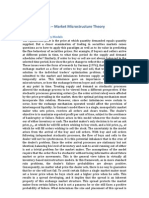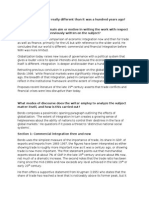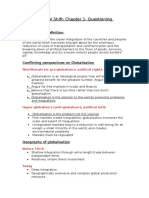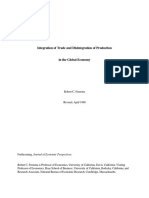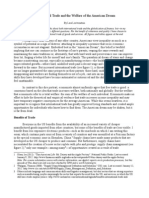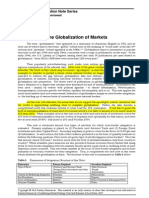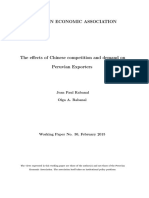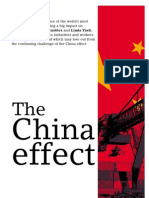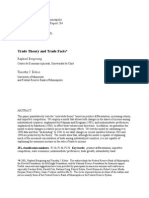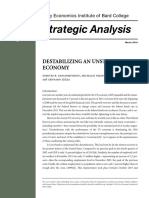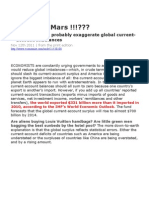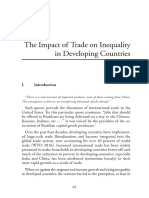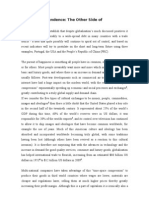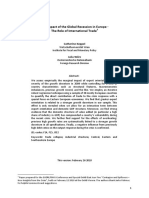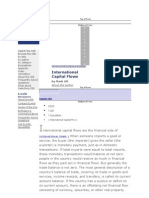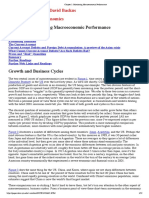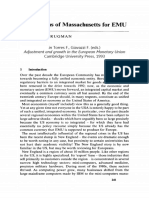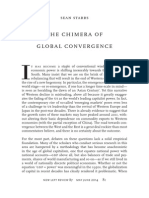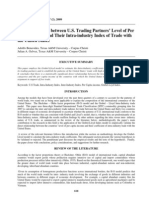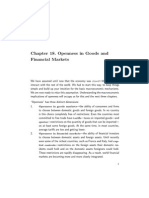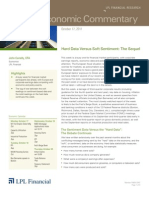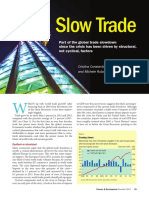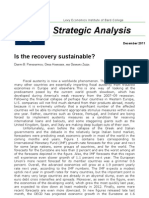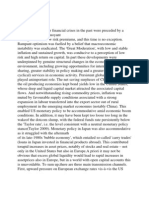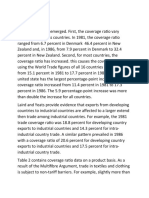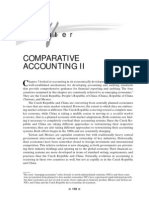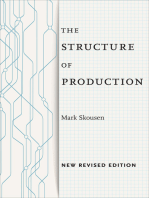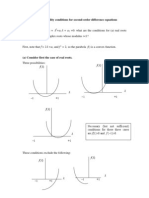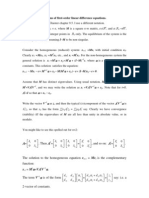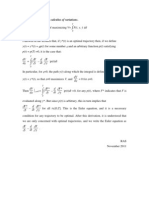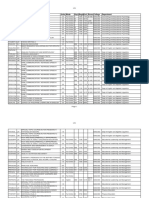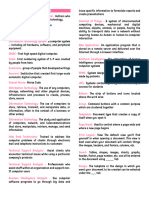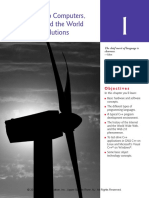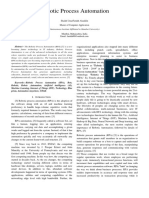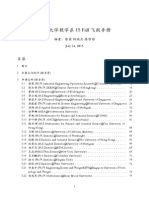PK Bpea Draft
PK Bpea Draft
Uploaded by
metaxurgioCopyright:
Available Formats
PK Bpea Draft
PK Bpea Draft
Uploaded by
metaxurgioOriginal Title
Copyright
Available Formats
Share this document
Did you find this document useful?
Is this content inappropriate?
Copyright:
Available Formats
PK Bpea Draft
PK Bpea Draft
Uploaded by
metaxurgioCopyright:
Available Formats
TRADE AND WAGES, RECONSIDERED
Paul Krugman
February 2008
This is a very preliminary draft for the spring meeting of the Brookings Panel on Economic
Activity. Comments welcome.
2
There has been a great transformation in the nature of world trade over the past three decades.
Prior to the late 70s developing countries overwhelmingly exported primary products rather than
manufactured goods; one relic of that era is that we still sometimes refer to wealthy nations as
'industrial countries, when the Iact is that industry currently accounts for almost twice as high a
share of GDP in China as it does in the United States. Since then, however, developing countries
have increasingly become major exporters of manufactured goods, and latterly selected services
as well.
From the beginning of this transformation it was apparent to international economists that the
new pattern of trade might pose problems for low-wage workers in wealthy nations. Standard
textbook analysis tells us that to the extent that trade is driven by international differences in
factor abundance, the classic analysis of Stolper and Samuelson (1941) which says that trade
can have very strong effects on income distribution -- should apply. In particular, if trade with
labor-abundant countries leads to a reduction in the relative price of labor-intensive goods, this
should, other things equal, reduce the real wages of less-educated workers, both relative to other
workers and in absolute terms. And in the 1980s, as the United States began to experience a
marked rise in inequality, including a large rise in skill differentials, it was natural to think that
growing imports of labor-intensive goods from low-wage countries might be a major culprit.
But is the effect of trade on wages quantitatively important? A number of studies conducted
during the 1990s concluded that the effects of North-South trade on inequality were modest.
Table 1 summarizes several well-known estimates, together with one crucial aspect of each: the
date of the latest data incorporated in the estimate.
3
For a variety of reasons, possibly including the reduction in concerns about wages during the
economic boom of the later 1990s, the focus of discussion in international economics then
shifted away from the distributional effects of trade in manufactured goods with developing
countries. When concerns about trade began to make headlines again, they tended to focus on the
new and novel in particular, the phenomenon of services outsourcing, which Alan Blinder
(2006), in a much-quoted popular article, went so far as to call a second Industrial Revolution.
Until recently, however, surprisingly little attention was given to the increasingly out-of-date
nature of the data behind the reassuring consensus that trade has only modest effects on income
distribution. Yet the problem is obvious, and was in fact noted by Ben Bernanke (2007) last year:
'Unfortunately, much of the available empirical research on the influence of trade on earnings
inequality dates from the 1980s and 1990s and thus does not address later developments. And
there have been a lot of later developments.
Figure 1 shows U.S. imports of manufactured goods as a percentage of GDP since 1989, divided
between imports from developing countries and imports from advanced countries.
1
It turns out
that developing-country imports have roughly doubled as a share of the economy since the
studies that concluded that the effect of trade on income inequality was modest. This seems, at
first glance, to suggest that we should scale up our estimates accordingly. Bivens (2007) has
done just that with the simple model I offered in 1995, concluding that the distributional effects
of trade are now much larger.
1
Throughout this paper, manufactured goods are defined using the NAICS classiIication. 'Advanced countries are
defined as the OECD less Korea, Mexico, and Turkey; developing countries are everyone else.
4
And there`s another aspect to the change in trade: as we`ll see, the developing countries that
account for most of the expansion in trade since the early 1990s are substantially lower-wage,
relative to advanced countries, than the developing countries that were the main focus of concern
in the original literature. China, in particular, is estimated by the Bureau of Labor Statistics
(2006) to have hourly compensation in manufacturing that is equal to only 3 percent of the U.S.
level. Again, this shift to lower-wage sources of imports seems to suggest that the distributional
effects of trade may well be considerably larger now than they were in the early 1990s.
But should we jump to the conclusion that the eIIects oI trade on distribution weren`t serious
then, but that they are now? It turns out that there`s a problem: although the 'macro picture
suggests that the distributional effects of trade should have gotten substantially larger, detailed
calculations of the factor content of trade which played a key role in some earlier analyses do
not seem to support the conclusion that the effects of trade on income distribution have grown
larger. This result, in turn, rests on what appears, in the data, to be a marked increase in the
sophistication of the goods the United States imports from developing countries in particular, a
sharp increase in imports of computers and electronic products compared with traditional labor-
intensive goods such as apparel.
Lawrence (2008), in a study that shares the same motivation as this paper, essentially concludes
from the evidence on factor content and apparent rising sophistication that the rapid growth of
imports from developing countries has not, in fact, been a source of rising inequality. But this
conclusion is, in my view, too quick to dismiss what seems like an important paradox. On one
side, the United States and other advanced countries have seen a surge in imports from countries
that are substantially poorer and more labor-abundant than the third-world exporters that created
so much anxiety a dozen years ago. On the other side, we seem to be importing goods that are
5
more skill-intensive and less labor-intensive than beIore. As we`ll see, the most important source
of this paradox lies in the information technology sector: for the most part there is a clear
tendency for developing countries to export labor-intensive products, but large third-world
exports of computers and electronics stand out as a clear anomaly.
One possible resolution of this seeming paradox is that the data on which factor-content
estimates are based suffer from severe aggregation problems that developing countries are
specializing in labor-intensive niches within otherwise skill-intensive sectors, especially in
computers and electronics. I`ll make that case later in the paper, while admitting that the
evidence is fragmentary. If this is the correct interpretation, however, the effect of rapid trade
growth on wage inequality may indeed have been significant.
The remainder of this paper is in four parts. The first part offers an overview of changing U.S.
trade with developing countries, in a way that sets the stage for the later puzzle. The second part
describes the theoretical basis for analyzing the distributional effects of trade, then shows how
macro-level calculations and factor content analysis yield divergent conclusions. The third part
turns to the case for aggregation problems and the implications of vertical specialization within
industries. A final part considers the implications both for further research and for policy.
The changing pattern of trade
Figure 1 showed the dramatic rise in U.S. imports of manufactured goods from developing
countries since 1989. One qualification that needs to be made right away is that to some extent
this rise reflects the overall movement of the United States into massive trade deficit. The
theoretical analysis later in this paper suggests that the average of imports and exports may be a
6
better guide to likely distributional effects than imports alone. Figure 2 shows this number for
U.S. trade in manufactured with developing and advanced countries; the rise in developing
country trade is slightly less dramatic, but still impressive. Also note that 2006 marked a
watershed: in that year, for the first time, the United States began doing more overall trade in
manufactured goods with developing countries than with other advanced countries.
This rapid growth in U.S. trade with developing countries mainly took the form of increased
trade with countries that were only minor players in the early 1990s. At the time of the original
literature on trade and income distribution, North-South manufactured trade was still, to a large
extent, trade involving the original Iour Asian 'tigers: South Korea, Taiwan, Hong Kong, and
Singapore. Since then, however, U.S. trade growth with developing countries has principally
involved China, Mexico, and some smaller players. Figure 3 is an area chart of U.S.
manufactured imports from developing countries, again as a percentage of GDP; it shows a
modest relative decline for the original tigers and a large rise for Mexico and especially China.
This changing direction of North-South trade has one immediate implication: the aspect of this
trade that initially attracted so much (often hostile) attention the fact that we were now
importing manufactured goods from countries with low wages by advanced-country standards
is much more extreme now that it was in the early 1990s. In 1990, according to BLS estimates,
the four original tigers had average hourly compensation in manufacturing equal to 25% of U.S.
levels. By 1995 that had risen to 39% of U.S. levels. But as of 2005 the BLS estimated that
Mexico had hourly compensation only 11% of the U.S. level, and China only slightly more than
3%.
7
As a result, one trend that was often cited in the early 90s as a reason to discount fears about the
effect of trade on wages the fact that the average wage of U.S. trading partners was actually
rising relative to the U.S. level has gone into reverse. Table 2 shows the top 10 U.S. trading
partners and the average hourly compensation of manufacturing workers in that group, weighted
by the value of bilateral trade and expressed as a percentage of the U.S. level, since 1975. This
measure did indeed rise from 1975 to 1990, reflecting rising relative wages both in advanced-
country trading partners and in the original Asian tiger economies. Since 1990, however, the
rapidly rising weight of China and, to a lesser extent, Mexico has driven the index down by
approximately 20 percent.
2
What accounts for the rapid growth of manufactured imports from these new players? China`s
economy, at least, has grown very rapidly, and one might imagine that the growth oI China`s
exports is simply a reflection of its overall growth. Simple gravity models, in which the trade
between any pair of countries reflects the product of their GDPs, adjusted for the distance
between them, generally work quite well and have become a standard tool for interpreting the
overall pattern of trade. And such a model would lead us to expect U.S. imports from China as a
percentage of GDP to rise, other things equal, in proportion to Chinese GDP as a share of U.S.
GDP.
In fact, however, U.S. imports from China have risen much more rapidly than the growth of the
Chinese economy, on its own, would have led us to expect. Table 3 compares the growth in
Chinese and Mexican GDP as a share of US GDP with imports from each country as a
2
The most commonly used measure of the relative wages of U.S. trading partners, from the Bureau of Labor
Statistics (2006), looks somewhat different from Table 2: it shows a more rapid rise between 1975 and 1990, from
62 to 80, and no change from 1990 to 2005. However, the BLS measure is fixed-weight: hourly compensation in
each country is weighted by 2004 trade with the United States. As a result, the BLS index does not reflect the shift
of U.S. manufactures trade to developing countries.
8
percentage of US GDP. Chinese GDP, at market exchange rates, has tripled relative to the United
States but US imports of manufactured goods from China have increased more than eightfold
as a share oI GDP. Mexico`s GDP as a share oI US GDP has risen about 40 percent, but
manufactured exports have tripled relative to US GDP.
The obvious explanation oI this 'excess growth in manuIactured exports is that it reflects
reduced barriers to trade, which have led to greater international specialization and hence greater
trade. In the case oI Mexico, it`s natural to guess that NAFTA has played an important role,
although much of the growth in Mexican exports may also reflect two other factors: the delayed
eIIects oI Mexico`s dramatic unilateral liberalization oI trade between 1985 and 1988, and the
weak peso that followed the 1994-5 financial crisis.
In the case of China, there is no comparable break in policy. However, work by Hummels, Ishii
and Yi (2003) suggests that even modest declines in trade costs can lead to large increases in the
volume of trade by encouraging vertical specialization the breakup of the production process
into geographically separated stages. Thus rapid growth in Chinese exports might reflect declines
in the cost of international communication and shipping.
One piece of evidence that may support the view that rapid growth in imports from developing
countries reflects declining trade costs, both explicit and implicit, is the changing composition of
these imports. A quick way to see the extent of this change in composition is to rely on a
distinction introduced by Faberman (2004). In analyzing job loss and gain he distinguishes a
group oI 'trade sensitive industries (at the NAICS three-digit level) with very large import
shares that also corresponds quite well to goods that we traditionally associated with third-world
exports. Figure 4 shows the long-term trend in U.S. imports of manufactured goods from
9
developing countries as a percentage oI GDP, divided between 'trade sensitive and other goods.
Even in 1989, it turns out, traditional third-world manufactured exports accounted for less than
half of U.S. imports from developing countries. More to the point, however, the bulk of the
growth in imports since then has come from non-traditional sectors.
What are these non-traditional goods? Figure 5 shows the change in imports from developing
countries as a share of GDP by three-digit NAICS sector, from largest to smallest. The striking
point is, of course, the extraordinary growth in imports of computers and electronics.
Modeling the effects of trade on income distribution
There have been two major waves of innovation in international trade theory over the roughly 30
years since developing-country exports of manufactured goods began to be a significant concern:
the increasing returns/imperfect competition revolution of the 1980s and the more recent focus
on intrafirm differences in productivity and propensity to export within industries. It is not clear,
however, how to apply the insights of either set of ideas to the question of distributional effects
of developing-country exports. As a result, most analysis of this issue continues to rely on the
simple perfectly competitive factor-proportions model.
The first key insight from this model is the Stolper-Samuelson relationship between goods prices
and factor prices. Consider a world in which there are two factors of production, skilled labor
and unskilled labor, and two goods produced competitively under constant returns to scale, a
skill-intensive good X and a labor-intensive good Y. Assume that workers move freely between
firms and industries, so that all workers of each type receive the same wage. Finally, assume
provisionally that an economy produces both goods. Then there is a one-to-one relationship
10
between the relative prices of the two goods and the relative wages of the two types of labor.
Letting a 'hat represent proportional rate oI change,
)
where
SX
,
SY
are the shares of skilled labor in the production cost of X and Y respectively.
Figure 6 completes the story. The left panel shows the relationship between relative goods prices
and relative factor prices. The right panel shows the relationship between factor prices and the
ratio of skilled to unskilled labor used in production. In each industry, a rise in the relative wage
of skilled workers leads to a fall in the ratio of skilled to unskilled workers. This is one way to
see the logic behind the Stolper-Samuelson result. As long as the country continues to produce
both goods, a rise in the relative price of the skill-intensive good must lead to a rise in the
relative wages of skilled workers. This implies a fall in the ratio of skilled to unskilled workers in
both industries and hence a fall in the marginal productivity of unskilled workers in terms of
both goods. And that, in turn, means that the real wage of unskilled workers unambiguously
falls.
It`s worth noting one more point about this analysis: the Stolper-Samuelson process involves a
complex reshuffling of resources between industries sort of a swing-around-and-change-
partners move. Consider what happens, according to this model, if there is a rise in the relative
price of X. Production within each industry becomes less skill-intensive, yet overall employment
of both factors remains unchanged because the industrial mix of production shifts toward skill-
intensive industries. This is not a process one should expect to play out in full in the short run;
the moral I would take from this is that Stolper-Samuelson should not be taken too seriously
when interpreting data over short periods, say 5 years.
11
But the focus of this paper is on a somewhat longer period the years since the early 1990s,
whose data were the basis for the relatively benign estimates of the effect of trade on wages that
still dominate discussion. Are the data since then consistent with a strong Stolper-Samuelson
effect?
At first glance, the answer appears to be yes.
Consider first how prices have changed. The Bureau of Labor Statistics offers data on the prices
of manufactured imports from developing and advanced countries. If we assume that developing
countries export labor-intensive goods to the United States while advanced countries export skill-
intensive goods (an assumption that we`ll conIirm with a major asterisk the case of computers
and electronics -- in the next section), the ratio of these prices should offer a measure of the
relative price of labor-intensive goods. Figure 7 shows the log of this ratio, normalized so that
1995=0. It seems that there has indeed been a substantial decline in the relative price of labor-
intensive goods since the mid-1990s.
Consider next changes in relative wages. Figure 8 shows two widely used indicators of wage
differentials: the 90-50 ratio of hourly wages, and the college-noncollege ratio. Both are shown
for men only, to abstract from changes in sex differentials; both are also expressed in logs,
normalized so that 1995=0. Both measures have risen substantially since 1995.
It should be pointed out that Lawrence (2008) reaches a different conclusion, arguing that trends
in relative wages are not consistent with a trade-driven story. This different in interpretation
arises, I believe, from two factors. First, Lawrence uses earnings data aggregated across sexes,
which does not show as strong a rise in inequality as the male-only data. Second, he focuses on
the period since 2000 rather than the longer stretch since the mid-1990s.
12
I would argue that this short-term focus is problematic in two respects. First, on general
principles it`s not clear what one learns Irom very short-term movements in relative wages. As
argued above, the implied adjustment from Stolper-Samuelson involves a complex reallocation
of resources across industries, making it unsuitable for short-term analysis. Second, more
specifically, the period since 1995 includes a major boom-bust cycle in high-technology
industries. The technology bubble of the late 1990s probably elevated the education premium,
while the subsequent bust caused that premium to deflate. As a result, inferences from the
movement in inequality during the first few years after the tech bust should be taken with a grain
of salt.
Perhaps the more general point is that Stolper-Samuelson is a ceteris paribus proposition, and
cannot be refuted or, to be sure, confirmed based on the movement of relative wages alone.
That said, the combination of the price changes shown in Figure 9 and the wage changes shown
in Figure 10 does look reasonably supportive of the proposition that rapid growth in North-South
trade since the studies of the mid-90s has made the effects on inequality substantially larger.
There is, however, a big problem with that conclusion: the result of using the methods I and
others applied to the subject of trade and wages in the 90s to more recent data does not, at least
on first appearances, fit the story.
There was a fairly heated dispute in the 1990s over the appropriate way to analyze the effects of
North-South trade on wages. Some economists, notably Leamer (1994) argued that since the
relationship shown in Figure 6 is between goods prices and factor prices, the only legitimate
approach is to rely on price information, rather than on the volume of trade, which is
endogenous. Others, myself included, argued that this represented a confusion between the
13
question of how best to present models with the question of constructing the appropriate thought
experiment for analysis it makes sense to present Stolper-Samuelson as a goods-price-factor-
price relationship, but in the real world prices are as endogenous as trade volumes. The
appropriate method, I argued in Krugman (1995), was 'but Ior analysis: compare goods and
factor prices with an estimate of what they would have been but for the opportunity to engage in
manufactures trade with developing countries. And this but-for analysis inevitably leans strongly
on calculations involving trade volumes.
Figure 9 illustrates the thought experiment from Krugman (1995). As in Figure 6, we assume
that there are two goods, one skill-intensive, one labor-intensive. PPF represents the production
possibilities of an aggregated OECD. If it were not possible to trade skill-intensive goods for
labor-intensive imports from developing countries that is, but for the possibility of North-South
trade equilibrium would be at the autarkic point A. In fact, however, this possibility exists; the
opportunities for trade with newly industrializing economies are represented by the offer curve
NIEO. As a result, equilibrium production is at Q while equilibrium consumption is at C, with
the line PP representing relative prices in trade. The relative price of skill-intensive goods is
higher, and that of labor-intensive goods lower, than would obtain in the absence of trade.
Hence, the Stolper-Samuelson effect applies.
In the original analysis I created an extremely simple CGE model to calculate a back-of-the-
envelope estimate of this but-for effect. This appears at first sight to be a significantly different
approach from analyses such as that of Borjas, Freeman, and Katz (1997), which instead try to
calculate the factor content of trade the factors of production embodied in imports and exports.
However, in later work (Krugman (1996), Krugman (2000)), it became apparent that the factor
14
content approach, interpreted carefully, is fully consistent with an analysis based on trade flows
and their effect on relative prices.
Figure 10 shows how this reconciliation can be carried out. Imagine holding goods prices
constant while altering the economy`s Iactor endowment, subtracting skilled labor while adding
unskilled labor. This would have the effect of shifting the production possibility frontier inward
at the lower right, but upward at the upper left, as illustrated by the shift from the production
possibility frontier PPF
1
to PPF
2
. Production would also shift, at constant goods prices, toward
less output of the skill-intensive good and more output of the labor-intensive good. More
specifically, suppose that at the initial factor prices the value of factors added is equal to the
value of factors subtracted. Then production would shift northwest up the relative price line PP.
If the change in factor endowments is sufficiently large, production will reach point C that is,
production will match consumption, so that trade is eliminated. And what is this change in factor
endowments? It is precisely equal to the factor content of the initial volume trade, as measured
using the Iactor content oI each good`s production per dollar of value in the advanced economy
(not in the developing country) under the actual trading regime.
Now, imagine that after we have added the factor content of trade to the advanced economy,
thereby eliminating the need for actual trade, we do a further thought experiment, in which we do
two things: first, we eliminate the possibility of trade, and then we reverse the change in factor
endowments. This would shift the production possibility frontier back to PPF
1
, but because trade
is no longer possible, consumption, production and relative prices would end up at the original
autarky point A.
15
This may seem rather roundabout, but what it says is the following: the but-for thought
experiment of eliminating North-South trade has the same effect on wages as another thought
experiment in which we take a non-trading economy whose resources include the actual
economy`s Iactor endowment plus the factor content of the real economy`s trade, and then
eliminate that difference in factor endowments. In this sense, then, the factor content approach,
carefully interpreted, is equivalent to the but-for trade analysis.
There are two advantages to thinking about the issue in terms of factor content. One is that it
simplifies the interpretation of any structural model. In general, the results of any such model
depend on all the parameters factor shares in production, goods shares in spending, and all the
relevant elasticities of substitution in both production and consumption. However, thinking in
terms of factor content makes it clear that these parameters matter only insofar as they affect one
derived number, the aggregate elasticity of substitution between skilled and unskilled labor. This
simplifies sensitivity analysis, and in general helps clarify interpretation.
3
The other advantage of thinking in terms of factor content is that it simplifies the task of
empirical work or at least that it seemed to do so in the past. Rather than having to calibrate a
full model, the researcher can simply estimate the factor content of trade, which is informative in
itself, and assess likely impacts by examining the implications of alternative aggregate
elasticities of substitution.
All of this assumes that we can do a reasonably good job of measuring factor content. Before we
get there, however, it`s useIul to extend the analysis to allow Ior an important Ieature oI U.S.
trade, especially recently: large trade deficits.
3
It`s important to note, however, that the relevant elasticity oI substitution between Iactors is the one that would
prevail in the absence of trade. So it is somewhat problematic to rely, as for example Borjas, Freeman, and Katz
(1997) do, on estimates of this elasticity from time series that include a period of significant trade.
16
Figures 9 and 10 are real-trade theory diagrams, assuming, as must be the case under standard
real-trade models, that trade is balanced. Clearly that`s not a reasonable assumption Ior the
United States today, which runs large trade deficits financed by capital inflows. (Circa 2005 a
rough description of the U.S. economy was that we made a living selling each other houses,
paying Ior them with money borrowed Irom China.) However, it`s possible to use the Iactor-
content approach under conditions of trade deficit provided that we make two further
assumptions. First, we assume that the effects of capital inflows on demand are equivalent to a
transfer payment made to domestic households. (That is, capital inflows are spent in the same
way as domestically earned income.) Second, we assume that all domestic consumers have
identical homothetic preferences so that the composition of spending does not depend on who
is receiving income.
Under these assumptions, the factor-content exercise can be represented by Figure 11. Here the
economy`s actual production and consumption are once again at Q and C, but this time the value
of consumption at world prices PP is greater than that of production. The difference is the trade
deficit, represented as a transfer of income to domestic consumers. Again, it`s possible to
construct a hypothetical economy that would produce the actual economy`s consumption without
the need for trade; this can be done by adding the actual factor content of trade to the original
economy, which shifts the production possibility frontier from PPF
1
to PPF
2
. The effect of trade
on factor prices can then be inferred by subtracting the factor content of trade out again. Because
of the assumption of homothetic preferences, the effect on relative factor prices depends on the
extent to which the ratio of factors is altered in this exercise. In particular, even if a country runs
so large a trade deficit that it is implicitly an importer of both skilled and unskilled labor, trade
still raises the skill premium as long as constructing the hypothetical no-trade economy requires
17
increasing the quantity of unskilled labor by more, in percentage terms, than the quantity of
skilled labor.
And now we get to the fundamental empirical puzzle. In the early to mid 1990s, factor content
exercises indicated a significant though modest move in the expected direction. The most recent
estimates, however, suggest that the dramatic expansion of imports from low-wage countries
since 1990 has not significantly enlarged the factor content of trade.
Table 4 shows estimates oI 'job displacement by education level another name for factor
content -- from Mishel et. al (2007). The estimates were constructed using changes in the ratios
of imports and exports to sales within each 4-digit NAICS industry to estimate changes in sales
due to trade; these estimates were then run through the input-output tables to estimate total
implied changes in output; finally, estimates of college and noncollege workers per unit of output
from U.S. data were used to estimate factor content.
What the estimate shows is that rising trade deficits have made the United States a consistent
importer of both highly educated and less educated labor that is, the U.S. picture looks like
Figure 11, with factor content arising from a trade deficit as well as comparative advantage,
rather than Figure 10. Nonetheless, prior to 1989 the estimated effect of trade was a relative
increase in the effective supply of less-educated labor.
Since then, however, the calculations of Mishel et. al. indicate little net effect of trade on relative
effective factor supplies. The obvious explanation lies in the trends illustrated in Figures 4 and 5:
although the traditional manufactured exports of developing countries to the United States are
labor-intensive goods like apparel, the growth in developing-country exports has been
concentrated in nontraditional sectors, especially computers and electronics.
18
As we`ll see next, the apparent strong comparative advantage oI developing countries in these
industries seems anomalous unless the exports of developing countries are concentrated in
labor-intensive sub-sectors within the industries.
Within-industry specialization and the problem of interpretation
A useful overview of the seemingly anomalous nature of some developing-country exports can
be obtained by using a technique suggested by Romalis (2004). Romalis provided impressive
evidence of the continuing relevance of Heckscher-Ohlin trade theory based on an analysis of the
sources of U.S. manufactured imports. He showed that the United States does tend,
systematically, to import skill-intensive goods from advanced countries and labor-intensive
goods from developing countries, although the relationship is far from perfect an imperfection
he ascribed to the interaction of product differentiation and transport costs, as modeled in
Krugman (1980). An alternative interpretation, of course, is that the evidence is blurred by
measurement error.
Figure 12 is a simple Romalis scatterplot, deliberately conducted at a relatively high level of
aggregation. The data points are 3-digit NAICS industries. The horizontal axis shows skill
intensity as proxied by the share of nonproduction workers in employment. The vertical axis
shows the share of developing countries in U.S. imports within the industry. It is immediately
apparent that most industries fall along a downward-sloping 'main sequence in which
developing countries tend to export labor-intensive goods, with apparel and other traditional
third-world exports at the upper left.
19
I have identified the industries that lie clearly off this main sequence. The industries at the lower
leIt pose little puzzle: the paper and wood products industries aren`t very skill-intensive, but U.S.
imports within these industries are, for reasons of resource abundance and geography, dominated
by Canada. (They have lumberjacks, and that`s OK.)
But what are we to make of NAICS 334, Computer and Electronic Products? In U.S. data it
ranks as the most skill-intensive of industries, yet it is also an industry in which more than three-
quarters of imports come from developing countries, especially China.
It seems a foregone conclusion that aggregation is a serious problem here; why not use more
disaggregated data? The answer is that within the limits of what is possible given current data,
we can do little to resolve the issue.
First of all, factor content analyses are limited by the level of disaggregation of the input-output
table, which is at 4-digit level. A 4-digit version of Figure 12 looks essentially the same: all the
components of 334 remain in the upper right corner. And even finer levels of disaggregation are
of relatively little help. To see why, look at Table 5, which shows the five 6-digit sectors with the
largest U.S. value-added within Computer and Electronics; collectively these sectors account for
57 percent of the total.
These are not homogeneous sectors. They are, however, globalized industries and it is easy to
find qualitative information suggesting that there is a division of labor between skill-intensive
operations and less skill-intensive operations within each industry.
This is obvious in the case of computers. First of all, there is a clear division between the types
of computers produced in emerging Asia primarily relatively low-end, standardized products
and those produced in advanced countries. Probably even more important, computer production
20
involves many stages, which are commonly split between advanced and developing economies
in a way clearly related to skill-intensity. This paper was written on a Lenovo notebook
computer. Lenovo, which took over the ThinkPad line from IBM, is famously a Chinese firm
whose headquarters and design operations are in North Carolina, and many of whose
components are produced in advanced countries. These operations help make the computer
industry look highly skill-intensive, if we rely on data from the U.S. Census of Manufactures;
this is not a good representation of what the industry looks like in China.
The caricature of the computer industry is that Japan and the U.S. make the innards, then China
adds the plastic shell. While it isn`t actually that simple, Dean, Fung and Wang (2007) estimate
that imported inputs account for 52 percent of the value of Chinese computer exports. Similarly,
imported inputs account for 41 percent of electronic device value, 46 percent for electronic
appliances, and 59 percent for communications equipment. And there is little question that in
each case the imported inputs are much more skill-intensive than the Chinese component of the
process.
Semiconductors might seem like a more homogeneous product. But even the semiconductor
industry is marked by an international division of labor that places skill-intensive operations in
advanced countries, labor-intensive operations in developing countries. As in the case of
computers, there is clear horizontal specialization, with developing countries producing
standardized commodity products the manuIacture oI 'standard chips, which are used in many
devices, is dominated by emerging Asia, but much higher-end production remains in advanced
countries.
21
There is also extensive vertical specialization. For example, Intel`s manuIacturing Iacilities are
of two kinds, because production takes place in two stages. First, circuits are printed, using
photolithography, on large disks oI silicon at 'waIer Iabs. Then the waIers are sent to assembly
and test Iacilities, where, according to Intel`s Iact sheet, 'each wafer is cut into individual silicon
dies, placed within external packages, and tested for functionality.
4
Where are these operations located? Intel has wafer fabs in the United States, Ireland, and Israel.
All of its assembly and test sites, by contrast, are in developing countries: they are located in
China, Costa Rica, Malaysia, and the Philippines, with a new site under construction in Vietnam.
In other words, within microprocessor manufacture, which is just one piece of the 6-digit
semiconductor sector, one stage of production is largely confined to advanced economies, while
another is largely confined to very low-wage countries.
All of this indicates that data showing a rapid rise in developing country exports, and Chinese
exports in particular, within sectors that are skill-intensive in the United States need to be taken
with large doses oI salt. As Jin (2006) puts it, 'The kind of gap seen in the electronic information
industry between the rapid expansion of the scale of the industry coupled with a low value-added
structure is evidence for China's role as an assembly base that is dependent upon overseas parts,
intermediary goods, and capital goods.
Schott (2007) offers additional evidence based on unit values, which are available in sectors
where the goods the U.S. imports have natural physical units. (Schott: 'Examples of the units
employed to classify products include dozens of shirts in apparel, square meters of carpet in
textiles and pounds of folic acid in chemicals.) It turns out that Chinese goods imported by the
4
See the Intel fact sheet: http://www.intel.com/pressroom/kits/manufacturing/manufacturing_qa.htm
22
United States have substantially lower unit values than goods within the same industries
imported from OECD countries e.g., the shirts we import from China are cheaper than shirts
imported from advanced countries. Furthermore, the gap in unit values has been rising over time,
suggesting that the relative sophistication of Chinese exports within any given industry has been
declining.
The broad picture, then, is that the apparent sophistication of imports from developing countries
is in large part a statistical illusion. Developing countries in general, and China in particular, are
probably specialized in very different niches within industries than the United States. But how
does all of the bear on the question of whether rising trade with developing countries has led to
rising wage inequality in the United States?
Several recent analyses, notably Schott (2004) and Lawrence (2008) have argued that such
specialization in effect protects advanced-country workers from distributional effects of trade by
placing OECD countries in a diIIerent 'cone oI diversification Irom developing countries.
Figure 14 (skip Figure 13 for now) illustrates the concept of cones of specialization, using a
Lerner diagram. The curves X, Z, and Y represent unit-value isoquants combinations of skilled
and unskilled labor input that produce an equal value`s worth (say $100) oI each good at current
market prices. The downward-sloping lines NN and SS reflect relative factor prices in advanced
countries and developing countries, respectively. E
N
and E
S
show the aggregate factor
endowment of each country.
As drawn, the figure is consistent with a pattern of specialization in which both advanced and
developing countries produce Z, advanced countries also produce skill-intensive X, and
23
developing countries also produces labor-intensive Y. Because both types of countries produce
Z, the two factor-price lines represent equal value; in advanced countries, the cost of producing
X is the same as that of producing an equal value of Z, so both goods can be produced there; the
same is true of Z and Y in developing countries; but producing a unit of X is more expensive in
developing countries than in advanced countries, while producing a unit of Z is less expensive.
Each country is able to fully employ all its workers because its endowment lies in the cone of
diversification illustrated in Figure 14.
The famous proposition that trade leads to equalization of factor prices a proposition closely
linked to the Stolper-Samuelson effect -- applies only if countries lie in the same cone. So the
suggestion that developing and advanced countries lie in different cones may seem to obviate
concerns about the distributional effects of trade. Thus Schott (2004) asserts that
'II all countries produce all goods, unskilled workers in the U.S. can be adversely affected by a
drop in the world price of labor-intensive products .Specialization, however, means that U.S.
firms produce a capital-intensive mix of goods and are therefore not threatened by cheap
imports.
Lawrence (2008) makes a similar argument. And in fact Krugman (1995) suggested that the
prospect of specialization offered one reason to doubt whether the distributional effects of trade
could get much larger than they were in the early 1990s.
But the evidence on specialization within industries, and vertical specialization in particular,
calls this interpretation into doubt. The shock behind rapid growth in developing-country exports
of manufactured goods does not appear to be developing-country growth leading to falling prices
of traditional exports such as apparel. Instead, what we seem to be looking at is a breakup of the
24
value chain that allows developing countries to take over labor-intensive portions of skill-
intensive industries. And this process can have consequences that closely resemble the Stolper-
Samuelson effect.
This point is difficult to make analytically, but comes across clearly in a numerical example.
[Note. in revision I will attempt to calibrate the example to bear a 'stvli:ed` resemblance to
actual data] For this example I assume that there are two final goods, Y and Z, produced using
two factors of production, skilled labor S and unskilled labor L. There are also two countries,
skill-abundant North and labor-abundant South. Production of Z is unskilled-labor-intensive.
Production of Y takes place in two stages: a skill-intensive 'component stage X and a labor-
intensive 'assembly stage.
Production functions and utility for the final goods are assumed to be Cobb-Douglas. Table 6
shows the assumed parameters and resource endowments.
The model is initially solved for equilibrium in the advanced country North in the absence of
trade. I then consider two trade scenarios. Case I involves the assumption that X and Y must be
physically co-located, so that there is in effect an aggregate XY industry. Case II allows X and Y
to be separated, with labor-intensive assembly in a different country from skill-intensive
component production.
Solution of the model requires determining both the pattern of specialization and relative goods
prices. In practice I guessed at the specialization pattern, solved through a process of successive
approximation for the equilibrium prices of both X and Y in terms of Z given the assumed
pattern, then checked to confirm that the implied factor prices did in fact support that pattern.
25
In the case in which X and Y had to be co-located, the pattern of specialization and the
associated factor prices were as illustrated in Figure 13. The developing country specialized in
the production of labor-intensive Z, while the advanced country remained unspecialized,
producing both the skill-intensive composite XY and Z. The relative price of Z was lower in the
advanced economy than it would have been in the absence of trade, so there is a standard
Stolper-Samuelson effect. As the first column in Table 7 shows, trade raises the real wages of
skilled workers while reducing those of unskilled workers.
But what happens if X and Y can be separated? Then the pattern of specialization becomes that
illustrated in Figure 14. Both countries continue to produce Z; meanwhile, the labor-intensive
portion of XY moves to the developing country while the skill-intensive portion remains in the
advanced country.
Figure 15 schematically illustrates the pattern of trade associated with each case, with the length
of the arrows indicating the value of exports from each country to the other. When X and Y must
be co-located, North exports Y to South and imports Z. (Think of this as trading computers for
apparel.) When it becomes possible to engage in vertical specialization, North exports X e.g.,
computer components to South, and imports both Z (apparel) and Y (assembled computers).
I`ve drawn the Iigure to suggest a large increase in the volume oI trade. In the numerical
example, the share of imports in North`s GDP rises Irom .136 to .535.
In a qualitative sense the change illustrated in Figure 15 seems to resemble the actual change in
North-South trade since the early 1990s, as documented in this paper. The share of advanced
country GDP spent on imports from developing countries rises sharply, because components are
shipped to developing countries for assembly, and the assembled goods are then exported back to
26
the first world. If X and Y continued to be classified as part of the same industry, however,
factor-content calculations based on advanced-country unit input coefficients would not suggest
an increase in effective imports of unskilled labor. And the measured export mix of developing
countries would seem to move upscale, toward more sophisticated products.
Yet as the second column in Table 7 shows, the actual effects on workers in the advanced
economy would reflect a sort of Stolper-Samuelson effect: the real wages of skilled workers
would rise, while those of unskilled workers would fall. Intuitively, the new ability to outsource
labor-intensive industry segments to the third world would depress the demand for less-skilled
workers, a shock not captured by data that lumped labor-intensive 'assembly operations
together with skill-intensive 'component manufacture.
We should note, however, that this example does suggest that the type of calculation performed
by Bivens (2007), in which the distributional effects of trade are assumed to be essentially
proportional to the import share a calculation suggested, admittedly, by my own 1995 paper
may exaggerate the distributional effects of recent trade growth. In this example, the trade share
grows fourfold, but the distributional effects do not grow in proportion. [Again, this example will
be revised to become more realistic in the next draft.] The reason, intuitively, is that much of the
content of the new imports from developing countries is actually skill-intensive production from
advanced countries [in the current version of the example, 90 percent], so that not as much
unskilled labor is displaced as the raw import figures seem to suggest. If the United States
imports computers from China, and China assembles computers largely from components made
in Japan, only the assembly share of the sales price reflects labor-intensive imports the rest is
indirect importing from a country whose factor prices are similar to our own.
27
Nonetheless, the analysis presented here indicates that the rapid rise in manufactures imports
from developing countries probably is, indeed, a force for growing inequality, and that factor
content calculations suggesting otherwise are missing the essence of what is happening.
Implications of the analysis
The starting point of this paper was the observation that the consensus that trade has only modest
effects on inequality rests on relatively old data that there has been a dramatic increase in
manufactured imports from developing countries since the early 1990s. And it is probably true
that this increase has been a force for greater inequality in the United States and other advanced
countries.
What really comes through from the analysis here, however, is the extent to which the changing
nature of world trade has outpaced our ability to engage in secure quantitative analysiseven
though this paper sets to one side the growth in service outsourcing, which has created so much
anxiety in recent years. Plain old trade in physical goods has become remarkably exotic.
In particular, the surge in developing-country exports of manufactures involves a peculiar
concentration on apparently sophisticated products, which seems at first to put worries about
distributional effects to rest. Yet there is good reason to believe that the apparent sophistication
of developing country exports is, in reality, largely a statistical illusion, created by the
phenomenon of vertical specialization in a world of low trade costs.
How can we quantify the actual effect of rising trade on wages? The answer, given the current
state oI the data, is that we can`t. As I`ve said, it`s likely that the rapid growth oI trade since the
early 1990s has had significant distributional effects. To put numbers to these effects, however,
28
we need a much better understanding of the increasingly fine-grained nature of international
specialization and trade.
REFERENCES
Bureau oI Labor Statistics (2006), 'International comparisons oI hourly compensation costs Ior
production workers in manuIacturing, www.bls.gov.
Bivens, J. (2007), 'Globalization, American wages, and inequality, EPI Working Paper 279.
Blinder, Alan (2006). Offshoring: The Next Industrial Revolution. Foreign Affairs Magazine.
Cline, William (1997). Trade and Income Distribution. Institute for International Economics.
Dean, J., Fung, K.C., and Wang, Z. (2007), 'Measuring the vertical specialization in Chinese
trade, USITC Working Paper.
Faberman, R. (2004), 'Gross job Ilows over the last two business cycles, BLS working paper
372.
Hummels, David; Ishii, Jun; and Yi, Kei-Mu. 'The Nature and Growth of Vertical Specialization
in World Trade. Journal oI International Economics 54 (2001): 75-96.
38
Krugman, Paul (1995), 'Growing World Trade: Causes and Consequences, Brookings Papers
on Economic Activity, Volume 1.
Lawrence, Robert (2008), Blue-collar blues: Is trade to blame for rising US income inequality?,
Institute for International Economics.
29
Mishel, L, and J. Bernstein and S. Allegretto (2006), The State of Working America, Cornell
University Press and the Economic Policy Institute (EPI).
Romalis, J. (2004), 'Factor proportions and the structure oI commodity trade, American
Economic Review.
Schott, P. (2004), 'One size Iits all? Heckscher-Ohlin specialization in international production,
NBER WP #8244
Schott, P. (2007), 'The relative sophistication oI Chinese exports, NBER WP #12173
Stolper, W. and Samuelson, P. (1941), 'Protection and real wages, Review oI Economic
Studies.
30
Table 1: Well-known estimates of the effect of trade on wages
Study Estimated effect on skilled- Date of data
unskilled wage ratio
Krugman (1995) 3% 1992
Lawrence (1996) 3% 1993
Cline (1997) 7% 1993
Borjas, Freeman 1.4% 1995
Katz (1997)
31
Table 2: Hourly compensation in top 10 U.S. trading partners as % of U.S. level
1975 1990 2005
Canada Canada Canada
Japan Japan Mexico
Germany Mexico China
UK Germany Japan
Mexico UK Germany
France Taiwan United Kingdom
Italy Korea Korea
Brazil France Taiwan
Neth Italy France
Belgium China Malaysia
76 81 65
Source: Compensation levels from BLS(2007). Trade values from Statistical Abstract. Note:
Chinese compensation level for 1990 set at 1% of U.S.. Malaysian level in 2005 estimated from
TK.
32
Table 3: Growth in GDP and manufactured exports
1990 2006
China:
GDP as % of US 6.7 20.0
Manufactured exports 0.24 2.13
% of US GDP
Mexico
GDP as % of US 4.6 6.4
Manufactured exports 0.37 1.16
% of US GDP
Table 4: Workers 'displaced by trade
1979-89 1989-2000 2000-04 employment, 2000
College graduate* 12.2% 21.2% 21.3% 25.6%
Non-college 87.8 78.9 78.7 74.4
Source: Mishel, Bernstein, and Allegretto (2007)
33
Table 5: 6-digit industries within Computer and Electronic Products
334413 Semiconductor & related device mfg
334111 Electronic computer mfg
334511 Search, detection, navigation, & guidance instrument mfg
334220 Radio & TV broadcasting & wireless communications equipment mfg
334210 Telephone apparatus mfg
Table 6: Assumptions for numerical example
Skilled labor share in X 0.8
Unskilled labor share in X 0.2
X share in Y 0.9
Skilled labor share in Y 0.01
Unskilled labor share in Y 0.09
Skilled labor share in Z 0.27
Unskilled labor share in Z 0.73
Share of Y in spending 0.5
Share of Z in spending 0.5
Skilled labor force in A 1
Unskilled labor force in A 1
Skilled labor force in C 0.1
Unskilled labor force in C 0.5
Table 7: Percent changes in real wages compared with no-trade situation
XY co-located Vertical specialization
Skilled workers +13.4 +15.9
Unskilled workers -11.8 -13.6
Import share in A 13.6 53.5
34
Figure 1
0
1
2
3
4
5
6
7
1
9
8
9
1
9
9
0
1
9
9
1
1
9
9
2
1
9
9
3
1
9
9
4
1
9
9
5
1
9
9
6
1
9
9
7
1
9
9
8
1
9
9
9
2
0
0
0
2
0
0
1
2
0
0
2
2
0
0
3
2
0
0
4
2
0
0
5
2
0
0
6
developing
advanced
Figure 1
I
m
p
o
r
t
s
o
f
m
a
n
u
f
a
c
t
u
r
e
s
,
%
o
f
G
D
P
35
Figure 2
0
1
2
3
4
5
6
adv
dev
36
0
1
2
3
4
5
6
7
1
9
8
9
1
9
9
0
1
9
9
1
1
9
9
2
1
9
9
3
1
9
9
4
1
9
9
5
1
9
9
6
1
9
9
7
1
9
9
8
1
9
9
9
2
0
0
0
2
0
0
1
2
0
0
2
2
0
0
3
2
0
0
4
2
0
0
5
2
0
0
6
nonsense
sensitive
Figure 4
37
Figure 5
0
0.2
0.4
0.6
0.8
1
1.2
1.4
3
3
4
-
-
C
O
M
P
U
T
E
R
A
N
D
3
3
6
-
-
T
R
A
N
S
P
O
R
T
A
T
I
O
N
3
3
9
-
-
M
I
S
C
E
L
L
A
N
E
O
U
S
3
3
1
-
-
P
R
I
M
A
R
Y
M
E
T
A
L
M
F
G
3
3
5
-
-
E
L
E
C
T
R
I
C
A
L
E
Q
U
I
P
M
E
N
T
;
3
3
3
-
-
M
A
C
H
I
N
E
R
Y
;
E
X
C
E
P
T
3
2
5
-
-
C
H
E
M
I
C
A
L
S
3
1
5
-
-
A
P
P
A
R
E
L
3
2
4
-
-
P
E
T
R
O
L
E
U
M
&
C
O
A
L
3
3
2
-
-
F
A
B
R
I
C
A
T
E
D
M
E
T
A
L
3
3
7
-
-
F
U
R
N
I
T
U
R
E
&
F
I
X
T
U
R
E
S
3
2
6
-
-
P
L
A
S
T
I
C
S
&
R
U
B
B
E
R
3
1
4
-
-
T
E
X
T
I
L
E
M
I
L
L
S
P
R
O
D
U
C
T
S
3
2
7
-
-
N
O
N
M
E
T
A
L
L
I
C
M
I
N
E
R
A
L
3
2
1
-
-
W
O
O
D
P
R
O
D
U
C
T
S
3
1
6
-
-
L
E
A
T
H
E
R
&
A
L
L
I
E
D
3
2
2
-
-
P
A
P
E
R
3
1
2
-
-
B
E
V
E
R
A
G
E
S
&
T
O
B
A
C
C
O
3
2
3
-
-
P
R
I
N
T
E
D
M
A
T
T
E
R
A
N
D
3
1
1
-
-
F
O
O
D
M
A
N
U
F
A
C
T
U
R
E
S
3
1
3
-
-
T
E
X
T
I
L
E
S
&
F
A
B
R
I
C
S
38
Figure 7
Figure 8
-0.2
-0.15
-0.1
-0.05
0
0.05
0.1
0.15
1990 1991 1992 1993 1994 1995 1996 1997 1998 1999 2000 2001 2002 2003 2004 2005 2006 2007
-0.25
-0.2
-0.15
-0.1
-0.05
0
0.05
0.1
0.15
1
9
7
3
1
9
7
5
1
9
7
7
1
9
7
9
1
9
8
1
1
9
8
3
1
9
8
5
1
9
8
7
1
9
8
9
1
9
9
1
1
9
9
3
1
9
9
5
1
9
9
7
1
9
9
9
2
0
0
1
2
0
0
3
2
0
0
5
90-50
college-hs
39
Skill-intensive
Labor-intensive
P
P
A
PPF
1
Figure 10
PPF
2
C
40
Skill-intensive
Labor-intensive
A
PPF
1
Figure 11
PPF
2
Trade deficit
Q
C
P
P
0
0.1
0.2
0.3
0.4
0.5
0.6
0.7
0.8
0.9
1
0 0.1 0.2 0.3 0.4 0.5 0.6
D
e
v
e
l
o
p
i
n
g
c
o
u
n
t
r
y
s
h
a
r
e
o
f
i
m
p
o
r
t
s
Skill intensity
Figure 12
334 (computers)
321 (wood products)
322 (paper)
41
Skilled labor
Unskilled labor
Z
XY
Figure 13
N
N
S
S
Skilled labor
Unskilled labor
Z
X
Figure 14
N
N
S
S
Y
E
N
E
S
42
Figure 15
Y Z
Before vertical
specialization
X
Z
Y
After vertical
specialization
N
S
N
S
You might also like
- Maureen O'Hara - Market Microstructure TheoryDocument2 pagesMaureen O'Hara - Market Microstructure Theorymetaxurgio50% (2)
- Science, Technology, and SocietyDocument18 pagesScience, Technology, and SocietyBJoy Sasi100% (10)
- Vocabulary Lists: Evolve Digital Level 3Document49 pagesVocabulary Lists: Evolve Digital Level 3lizet_ortegaNo ratings yet
- Is Globalization Today Really Different Than It Was A Hundred Years AgoDocument11 pagesIs Globalization Today Really Different Than It Was A Hundred Years Agonai09No ratings yet
- Dickens Global Shift NotesDocument15 pagesDickens Global Shift NotesTommy Ekundayo100% (1)
- Fortin - 1996 - The Great Canadian SlumpDocument28 pagesFortin - 1996 - The Great Canadian SlumpjpkoningNo ratings yet
- The Leading Indicators: A Short History of the Numbers That Rule Our WorldFrom EverandThe Leading Indicators: A Short History of the Numbers That Rule Our WorldRating: 3.5 out of 5 stars3.5/5 (23)
- GDP: A Brief but Affectionate History - Revised and expanded EditionFrom EverandGDP: A Brief but Affectionate History - Revised and expanded EditionRating: 3.5 out of 5 stars3.5/5 (20)
- Econ 6Document38 pagesEcon 6Justine Jireh PerezNo ratings yet
- Jep 2Document38 pagesJep 2jilfNo ratings yet
- Loewenstein - International Trade and The Welfare of The American DreamDocument7 pagesLoewenstein - International Trade and The Welfare of The American DreamlloewensNo ratings yet
- Explaining The American Boom: The Roles of Globalisation' and US Global Power - by Peter GowanDocument14 pagesExplaining The American Boom: The Roles of Globalisation' and US Global Power - by Peter Gowanamber1983No ratings yet
- Globalization of MarketsDocument11 pagesGlobalization of MarketsEconomiks PanviewsNo ratings yet
- Peruvian Economic Association: Jean Paul Rabanal Olga A. RabanalDocument24 pagesPeruvian Economic Association: Jean Paul Rabanal Olga A. RabanalGuillermo Raffo RamosNo ratings yet
- Venables YuehDocument8 pagesVenables YuehMatthew BakerNo ratings yet
- What Do Economists Mean by Globalization? Implications For Inflation and Monetary PolicyDocument20 pagesWhat Do Economists Mean by Globalization? Implications For Inflation and Monetary Policymaven woodNo ratings yet
- Beyond GDPDocument11 pagesBeyond GDPalearmesNo ratings yet
- Globalization S4Document10 pagesGlobalization S4Emilien MercenierNo ratings yet
- Trade Theory and Trade Facts : Raphael BergoeingDocument45 pagesTrade Theory and Trade Facts : Raphael BergoeingRavi ChandNo ratings yet
- Destablizing An Unstable EconomyDocument20 pagesDestablizing An Unstable EconomyfahdaliNo ratings yet
- Exports To Mars !!!???: Official Statistics Probably Exaggerate Global Current-Account ImbalancesDocument4 pagesExports To Mars !!!???: Official Statistics Probably Exaggerate Global Current-Account ImbalancesNicolas MarionNo ratings yet
- Pavcnik - Impact - Trade - Inequality - Developing - CountriesDocument54 pagesPavcnik - Impact - Trade - Inequality - Developing - CountriesРакель СтрельчукNo ratings yet
- Economics RealityDocument7 pagesEconomics RealityGera VillaNo ratings yet
- Financial Dependence: The Other Side of GlobalisationDocument6 pagesFinancial Dependence: The Other Side of GlobalisationChristian CopeNo ratings yet
- Keppel Woerz Aug2010Document22 pagesKeppel Woerz Aug2010Hoàng LongNo ratings yet
- Harms of GlobalizationDocument13 pagesHarms of GlobalizationPrinceakhtarNo ratings yet
- Aetikel EkonomiDocument36 pagesAetikel EkonominikenNo ratings yet
- HennDocument4 pagesHennGustavo Lima SoaresNo ratings yet
- Competitiveness ObsessionDocument10 pagesCompetitiveness ObsessionAndreea Telegdi MoodyNo ratings yet
- International Capital Flows: E N C y CL o P e D I A G SearchDocument15 pagesInternational Capital Flows: E N C y CL o P e D I A G SearchKhushbu ShrivastavNo ratings yet
- Alford 25 BDocument4 pagesAlford 25 BEugen RădulescuNo ratings yet
- Q2. Globalization Reduces Employment Opportunities. Explain?Document8 pagesQ2. Globalization Reduces Employment Opportunities. Explain?Sumeet VermaNo ratings yet
- Chapter 1 - Monitoring Macroeconomic Performance PDFDocument29 pagesChapter 1 - Monitoring Macroeconomic Performance PDFshivam jangidNo ratings yet
- Adjustment and Growth in The European Monetary Union - Paul KrugmanDocument21 pagesAdjustment and Growth in The European Monetary Union - Paul Krugmanskylord wiseNo ratings yet
- Part BDocument65 pagesPart BVasugi RNo ratings yet
- Salvatore Study-Guide ch01 PDFDocument5 pagesSalvatore Study-Guide ch01 PDFEconomics LabNo ratings yet
- Sean Starrs, The Chimera of Global ConvergenceDocument16 pagesSean Starrs, The Chimera of Global ConvergenceRob LucasNo ratings yet
- Current Trends in Strategic Management 1Document25 pagesCurrent Trends in Strategic Management 1Ashish Lakwani0% (1)
- The Relationship Between U.S. Trading Partners' Level of Per Capita Income and Their Intra-Industry Index of Trade With The United StatesDocument11 pagesThe Relationship Between U.S. Trading Partners' Level of Per Capita Income and Their Intra-Industry Index of Trade With The United StatesRecca DamayantiNo ratings yet
- Economic Policies Home AssignmentDocument7 pagesEconomic Policies Home AssignmentpalackmosokefeNo ratings yet
- Mit Ch18 NoteDocument42 pagesMit Ch18 Noteoakashler100% (1)
- Krugman 1995Document52 pagesKrugman 1995Christian KlammerNo ratings yet
- Weekly Economic Commentar 10-17-11Document4 pagesWeekly Economic Commentar 10-17-11monarchadvisorygroupNo ratings yet
- Raphael PDFDocument45 pagesRaphael PDFArsalan AhmedNo ratings yet
- International Finance: Trade Deficits: Bad or Good?Document12 pagesInternational Finance: Trade Deficits: Bad or Good?Yuri Walter AkiateNo ratings yet
- Williamson - 1998 - Globalization, Labor Markets and Policy Backlash in The PastDocument23 pagesWilliamson - 1998 - Globalization, Labor Markets and Policy Backlash in The Paste691295991No ratings yet
- Trade and GlobalizationDocument35 pagesTrade and GlobalizationHelder HRNo ratings yet
- ECO 615 Unit 1 LectureDocument11 pagesECO 615 Unit 1 LecturebuhleymapNo ratings yet
- Globalization in The 1990sDocument8 pagesGlobalization in The 1990sBhanu MehraNo ratings yet
- Slow Trade: Part of The Global Trade Slowdown Since The Crisis Has Been Driven by Structural, Not Cyclical, FactorsDocument3 pagesSlow Trade: Part of The Global Trade Slowdown Since The Crisis Has Been Driven by Structural, Not Cyclical, FactorsAlba Baranco PampliegaNo ratings yet
- China S Successors Special ReportDocument8 pagesChina S Successors Special ReportNenad PetrövicNo ratings yet
- From The Print Edition: Free Trade: Coming and Going. Truth and Myth About The Effects of Openness To TradeDocument4 pagesFrom The Print Edition: Free Trade: Coming and Going. Truth and Myth About The Effects of Openness To TradeGabriel StefanNo ratings yet
- A FishDocument3 pagesA Fishfreedomwood01No ratings yet
- Levy Economics Institute of Bard College Strategic Analysis December 2011 Is The Recovery Sustainable?Document20 pagesLevy Economics Institute of Bard College Strategic Analysis December 2011 Is The Recovery Sustainable?mrwonkishNo ratings yet
- Capitalist Globalization - ChinaDocument12 pagesCapitalist Globalization - Chinaegrino1No ratings yet
- ProQuestDocuments 2016-11-06Document8 pagesProQuestDocuments 2016-11-06JohnWillis22No ratings yet
- The Truth About Trade: What Critics Get Wrong About The Global EconomyDocument8 pagesThe Truth About Trade: What Critics Get Wrong About The Global EconomyMirjamNo ratings yet
- Origin ImpactDocument4 pagesOrigin Impacthiren_20984No ratings yet
- UntitledDocument15 pagesUntitledMrudula R GowdaNo ratings yet
- Why Globalization Is Going Nowhere Despite The Current PanicDocument3 pagesWhy Globalization Is Going Nowhere Despite The Current PanicIoana DiaconescuNo ratings yet
- Comparative AccountingDocument27 pagesComparative AccountingIkaa RachmaNo ratings yet
- The Structure of Production: New Revised EditionFrom EverandThe Structure of Production: New Revised EditionRating: 4 out of 5 stars4/5 (1)
- The Betrayal of American Prosperity: Free Market Delusions, America's Decline, and How We Must Compete in the Post-Dollar EraFrom EverandThe Betrayal of American Prosperity: Free Market Delusions, America's Decline, and How We Must Compete in the Post-Dollar EraNo ratings yet
- Stability DiffceDocument2 pagesStability DiffcemetaxurgioNo ratings yet
- 8.systems of Difference Equations NewDocument2 pages8.systems of Difference Equations NewmetaxurgioNo ratings yet
- z12. Calculus of VariationsDocument1 pagez12. Calculus of VariationsmetaxurgioNo ratings yet
- Cim Model Unit 1 QB With AnsDocument18 pagesCim Model Unit 1 QB With AnsSiva RamanNo ratings yet
- Abs 2Document64 pagesAbs 2Sourab SomasundarNo ratings yet
- DissertationDocument66 pagesDissertationChaitali GhodkeNo ratings yet
- Class I Syllabus 2024-25Document15 pagesClass I Syllabus 2024-25Sdo AmberNo ratings yet
- Collection of Computer Objective QuestionDocument72 pagesCollection of Computer Objective QuestionAbhishek ChakrabortyNo ratings yet
- Computer Science - Class 11 NotesDocument134 pagesComputer Science - Class 11 Notesabhhie100% (3)
- Computing Handbook Computer Science and Software Engineering 3rd Edition Allen B. Tucker 2024 scribd downloadDocument82 pagesComputing Handbook Computer Science and Software Engineering 3rd Edition Allen B. Tucker 2024 scribd downloadarmaisbekios100% (1)
- Lenovo h530 Userguide enDocument63 pagesLenovo h530 Userguide enfname lnameNo ratings yet
- Artificial Intelligence Handwritten Notes by Riya CompressDocument118 pagesArtificial Intelligence Handwritten Notes by Riya CompressraguramancmNo ratings yet
- Course Offerings Ug Term 3 AY2019 2020Document102 pagesCourse Offerings Ug Term 3 AY2019 2020Micky HuangNo ratings yet
- Vibration Meter: Model: VB-8203Document2 pagesVibration Meter: Model: VB-8203syedqutub16No ratings yet
- How Stuff Works HP Deskjet 3745Document10 pagesHow Stuff Works HP Deskjet 3745Deco DluxeNo ratings yet
- Itab Quiz ReviewerDocument3 pagesItab Quiz ReviewerchiyoangeliqueNo ratings yet
- BCS-11.solved Assignment 2018-19 - Watermark Ignou Assignment Wala PDFDocument39 pagesBCS-11.solved Assignment 2018-19 - Watermark Ignou Assignment Wala PDFNEW THINK CLASSESNo ratings yet
- 2.7 The Data Processing CycleDocument3 pages2.7 The Data Processing Cyclesiddu9682No ratings yet
- Computer NetworksDocument38 pagesComputer NetworksSaurabh G83% (6)
- Unit 1Document73 pagesUnit 1Rohan MehraNo ratings yet
- Computer Troubleshooting: Empowerment TechnologyDocument4 pagesComputer Troubleshooting: Empowerment TechnologyNorniña DiaNo ratings yet
- DEEDS REGISTRIES ACT AMENDMENT No 8 - 0 PDFDocument13 pagesDEEDS REGISTRIES ACT AMENDMENT No 8 - 0 PDFTafadzwa Matthew GarikaiNo ratings yet
- Cpphtp7 01 IMDocument7 pagesCpphtp7 01 IMZach FergerNo ratings yet
- Co Unit 1 NotesDocument51 pagesCo Unit 1 NotesKishan Bhat K100% (1)
- ITC Lecture 01Document21 pagesITC Lecture 01Momena MalikNo ratings yet
- Advanced BASICDocument194 pagesAdvanced BASICyudiyulesmanNo ratings yet
- Basic Computer Organization and Design-2Document23 pagesBasic Computer Organization and Design-2oraimpack.jagan.07No ratings yet
- Practical 1: AIM: Identify The Different Components of ComputerDocument6 pagesPractical 1: AIM: Identify The Different Components of Computermnatsu0432No ratings yet
- Computer Class PresentationDocument10 pagesComputer Class PresentationJosh UlakNo ratings yet
- Robotic Process Automation - Research PaperDocument5 pagesRobotic Process Automation - Research PaperAsif ShaikhNo ratings yet
- 15年数学系飞跃手册 (ver2 0)Document113 pages15年数学系飞跃手册 (ver2 0)matt100% (1)
